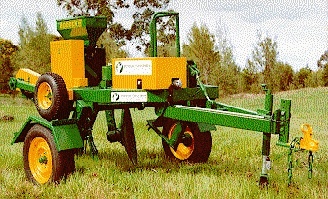Site PreparationThis is perhaps the most important area when preparing your direct seeding site. A well prepared surface area for seeding is essential for good results. All available ground moisture must be maximised for the emerging germinants. Conserving this moisture can be achieved by a good weed control program leading up to your seeding program. Where some weeds or grasses are a problem, a year lead-up spray program may be necessary. In most cases a good spray program after weeds and grasses have germinated is sufficient. This may have to be done twice, to control autumn and spring weed species. Some people in low rainfall areas will use a blade grader to clear away existing weed seed supply. This is often referred to as scalping, which results in a clean site for sowing. The mould board method of turning over the soil surface, particularly on high rainfall areas or heavy soils, also gives a good seeding surface. Whichever method is used, effective weed control during the first six months after sowing is essential for good results. Knockdown herbicides will give satisfactory results. In areas where stone or extremely hard soils are present, it can be advisable to use a ripper to break up soil before seeding. Seed Collection and Pre-TreatmentSelect the varieties you require in your seed project; not forgetting to add the understorey varieties. They are a very important addition to the final balance of vegetation. Further information on the understorey species can be gained by obtaining the Greening Australia pamphlet "Understorey". Time to collect seed depends on locality and species. Most legumes seed annually and are collected when ripe before falling out of the seed capsules. Other woody plants may hold their seed for many years, so can be collected at any time. However, summer months seem preferable, as time involved in seed release is much shorter. When collecting seed, you must analyse fruiting branches and become familiar with what are the mature seed fruits. Store seed in a dry area. Seed will release once green wood shrinks and dries out. When you have collected seed remove unwanted trash; by sieving. Clean seed can be stored until required. Keep in an airtight container away from ants, mice or other unwanted creatures that find seed palatable. You may dust seed with an appropriate insecticide to discourage foragers. Seed TreatmentFor Direct Seeding it is advisable for hard coated seed such as Acacia, Senna, Hardenbergia, Pultenaea, Templetonia etc to be covered by boiling water and allowed to cool before sowing. Fine seeds such as Myrtaceous varieties, Melaleuca, Eucalyptus, Callistemon, require no pre-treatment. Seeds from Callitris, Bursaria, and some of the cold climate eucalypts can benefit from cool, moist stratification. To test the seed's viability, carry out a simple germination test. This can be done by placing seed on damp paper in a warm sheltered situation with good light. Germination should be expected from 2-4 weeks. When collecting seed for your project, allow approximately 200-500 grams per kilometre sown. On higher rainfall areas, this can be reduced to 150-300 grams, while on low rainfall Mallee type sites, a rate of 300-500 grams per kilometre may be necessary. When to sowThis is often discussed, and varies between different areas. Soil types and rainfalls have to be considered. As a rule of thumb, in low rainfall areas 250-450 mm sow May-June, 450-550 mm, sow August-September, 500-700 mm sow September-October. Remember, the two factors that set off germination are temperature and moisture.
Post Germination HintsKeep watch for small predators, such as red legged earthmites at germination time - apply appropriate spray if these are numerous. A spray of water in the seed line in autumn or late spring if top surface soil is at all dry when sowing can be beneficial. If weeds become a problem early after seeding, spray both sides of seed row. A shield over the seed row is a good idea, but ensure no drift or spray makes contact with emerging seedlings in the seed row. This may not be necessary if good ground preparation has been achieved. Oversprays during the first autumn after sowing can be useful in retarding winter and spring weeds and grasses. A Promising FutureBy 1997 the word has got around that direct seeding could be the saviour of our bush, and can turn the tree decline around. The Greening Australia (South Australia) Inc team worked closely with revegetation officers of the Primary Industries' Department and went into most areas of the state, to demonstrate this technology. Research agencies are developing more sophisticated seeding machines, and carrying out scientific research on improving the seeding technology, and understanding more about native seed biology. By 1997 due to recent success, private landowners, and commercial revegetators have come on the scene to help with the enormous growth of this industry. In 1996 some 30 machines were working in South Australia,, numerous seed collection agencies had sprung up, and a report carried out by Greening Australia (South Australia) Inc, titled A Greener South Australia showed that direct seeding had turned a tree decline in 1989 to one of hope, and more trees were being established than being lost. Perhaps we are the first state in the Federation to achieve this. As we are the driest state, and perhaps the most treeless, it is something that many tree growers can feel proud of. The rest is now history. This article is a reproduction of a paper presented at the SGAP 19th Biennial Seminar which was held at Annesley College, Adelaide, 30 September to 3 October 1997. Neville Bonney has been involved with native plants since 1965 in many aspects - as a landscaper, propagator, lecturer, restorer, revegetator, author, promotor, and above all a love and passion for the great Australian landscape. He has also been involved with the national organization Greening Australia managing field operations in South Australia.  [Front Page] [Features] [Departments] [Society Home] [Subscribe] Australian Plants online - December 2000 |

